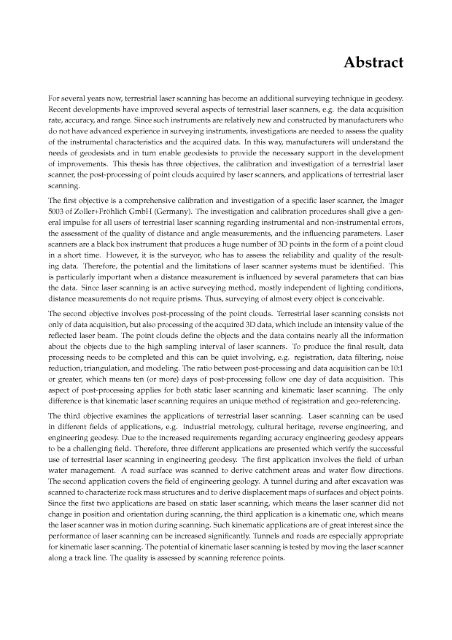Calibration of a Terrestrial Laser Scanner - Institute of Geodesy and ...
Calibration of a Terrestrial Laser Scanner - Institute of Geodesy and ...
Calibration of a Terrestrial Laser Scanner - Institute of Geodesy and ...
You also want an ePaper? Increase the reach of your titles
YUMPU automatically turns print PDFs into web optimized ePapers that Google loves.
AbstractFor several years now, terrestrial laser scanning has become an additional surveying technique in geodesy.Recent developments have improved several aspects <strong>of</strong> terrestrial laser scanners, e.g.the data acquisitionrate, accuracy, <strong>and</strong> range. Since such instruments are relatively new <strong>and</strong> constructed by manufacturers whodo not have advanced experience in surveying instruments, investigations are needed to assess the quality<strong>of</strong> the instrumental characteristics <strong>and</strong> the acquired data.In this way, manufacturers will underst<strong>and</strong> theneeds <strong>of</strong> geodesists <strong>and</strong> in turn enable geodesists to provide the necessary support in the development<strong>of</strong> improvements. This thesis has three objectives, the calibration <strong>and</strong> investigationscanner, the post-processing <strong>of</strong> point clouds acquired by laser scanners, <strong>and</strong> applicationsscanning.<strong>of</strong> a terrestrial laser<strong>of</strong> terrestrial laserThe first objective isa comprehensive calibration <strong>and</strong> investigation <strong>of</strong> a specific laser scanner, the Imager5003 <strong>of</strong> Zoller+Frohlich GmbH (Germany). The investigation <strong>and</strong> calibration procedures shall give a gen¬eral impulse for all users <strong>of</strong> terrestrial laser scanning regarding instrumental <strong>and</strong> non-instrumental errors,the assessment <strong>of</strong> the quality <strong>of</strong> distance <strong>and</strong> angle measurements, <strong>and</strong> the influencing parameters. <strong>Laser</strong>scanners are a black box instrument that produces a huge number <strong>of</strong> 3D points in the form <strong>of</strong> a point cloudin a short time. However, it is the surveyor, who has to assess the reliability <strong>and</strong> quality<strong>of</strong> the result¬ing data. Therefore, the potential <strong>and</strong> the limitations <strong>of</strong> laser scanner systemsmust be identified. Thisis particularly important when a distance measurement is influenced by several parameters that can biasthe data. Since laser scanning is an active surveying method, mostly independent <strong>of</strong> lighting conditions,distance measurements do not require prisms. Thus, surveying <strong>of</strong> almost every object is conceivable.The second objective involves post-processing <strong>of</strong> the point clouds.<strong>Terrestrial</strong> laser scanning consists notonly <strong>of</strong> data acquisition, but also processing <strong>of</strong> the acquired 3D data, which include an intensity value <strong>of</strong> thereflected laser beam. The point clouds define the objects <strong>and</strong> the data contains nearlyall the informationabout the objects due to the high sampling interval <strong>of</strong> laser scanners. To produce the final result, dataprocessing needs to be completed <strong>and</strong> this can be quiet involving, e.g. registration, data filtering, noisereduction, triangulation, <strong>and</strong> modeling. The ratio between post-processing <strong>and</strong> data acquisitioncan be 10:1orgreater, which means ten (or more) days <strong>of</strong> post-processing follow one day <strong>of</strong> data acquisition. Thisaspect <strong>of</strong> post-processing applies for both static laser scanning <strong>and</strong> kinematic laser scanning. The onlydifference is that kinematic laser scanning requires an unique method <strong>of</strong> registration <strong>and</strong> geo-referencing.The third objective examines the applications <strong>of</strong> terrestrial laser scanning.<strong>Laser</strong> scanningcan be usedin different fields <strong>of</strong> applications, e.g.industrial metrology, cultural heritage, reverse engineering, <strong>and</strong>engineering geodesy. Due to the increased requirements regarding accuracy engineering geodesy appearsto be a challenging field. Therefore, three different applications are presented which verifyuse <strong>of</strong> terrestrial laser scanning in engineering geodesy. The first applicationthe successfulinvolves the field <strong>of</strong> urbanwater management.A road surface was scanned to derive catchment areas <strong>and</strong> water flow directions.The second application covers the field <strong>of</strong> engineering geology. A tunnel during<strong>and</strong> after excavation wasscanned to characterize rock mass structures <strong>and</strong> to derive displacement maps <strong>of</strong> surfaces <strong>and</strong> object points.Since the first two applications are based on static laser scanning,which means the laser scanner did notchange in position <strong>and</strong> orientation during scanning, the third application is a kinematic one, which meansthe laser scanner was in motion during scanning. Such kinematic applications are <strong>of</strong> greatinterest since theperformance <strong>of</strong> laser scanning can be increased significantly. Tunnels <strong>and</strong> roads are especially appropriatefor kinematic laser scanning. The potential <strong>of</strong> kinematic laser scanning is tested by moving the laser scanneralong a track line. The quality is assessed by scanning reference points.












